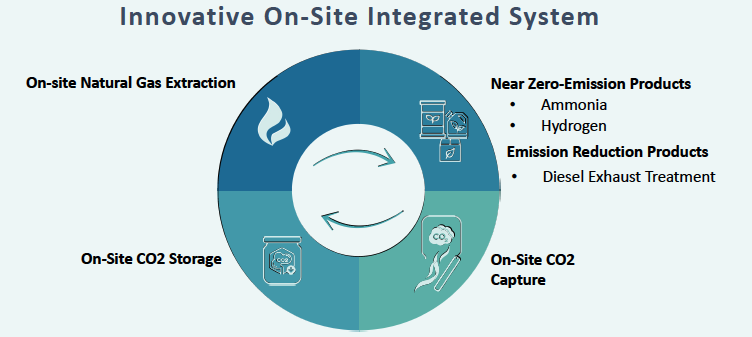By Cara Aungst

KeyState’s nearly $1 billion project will play a role in Pennsylvania becoming a ‘hydrogen superpower’ over the next 30 years, and Penn State is helping lead the way.
KeyState is in the second phase of engineering Pennsylvania’s first carbon capture and storage project, to be built in Clinton County. The gas synthesis project will extract stranded gas from Marcellus Shale to manufacture hydrogen, ammonia and urea, and permanently store the resulting CO2 nearly a mile underground.
The project is estimated to cost $950 million in upfront investments — more than the construction costs of Heinz Field/Acrisure Stadium, PPG Paints Arena and PNC Park combined — and anticipates $800 million in economic output over four years. KeyState Energy CEO Perry Babb says the project is part of Pennsylvania’s low-carbon future, and that KeyState’s collaboration with Penn State is helping lead the way.
“Now, the Commonwealth is leading the way to a low-carbon future for natural gas, with the integration of natural gas extraction and Co2 injection.”
“Pennsylvania has led many of America’s great energy and energy-related transitions: coal, rail, oil, nuclear and shale gas production,” he said. “Now, the Commonwealth is leading the way to a low-carbon future for natural gas, with the integration of natural gas extraction and C02 injection.”
The current phase of development is being backed by decarbonization investor OGCI Climate Investments, a coalition of global natural gas and oil majors focused on the large-scale carbon capture and storage to advance United Nations climate goals.

KeyState’s manufacturing facility will operate on a closed system of on-site gas production and CO2 storage within a 7,000-acre tract, with a 220-acre plant site, and feature all-new wells and a gathering system, continuous monitoring and a proprietary emissions remediation strategy.
“The project will therefore have verifiably some of the cleanest gas production in the world,” Babb said.
The natural gas that’s extracted will be used to produce very low-carbon hydrogen, which Babb says is a major step in the future of clean energy. “Pennsylvania will become a ‘hydrogen superpower’ over the next 30 years,” he said. “With the integration of natural gas extraction, separating CO2 from the hydrogen in methane and sending the CO2 back underground, we’ll be able to provide very low-carbon hydrogen and other products at a massive scale to the transportation, agriculture and manufacturing markets,” Babb said.
“Pennsylvania will become a ‘hydrogen superpower’ over the next 30 years.”
“Exactly in alignment:” Partnering with Penn State
Babb said the project, which aims to be operational by the end of 2026, will be working in close collaboration with Penn State.
“KeyState views its potential relationship with [Penn State] as vital on a variety of fronts, including workforce development, technology demonstration, joint research and development and collaboration on [Penn State] emission reduction goals,” he said. “In 2023, KeyState will seek an office suite at Innovation Park, which would grow into a project control/internship/learning center, to maximize the potential collaboration with [Penn State].”
Penn State’s head of the Department of Energy and Mineral Engineering, Sanjay Srinivasan, said his department has experts in areas of carbon capture and subsurface engineering, as well as processes for converting the produced methane into useful products such as ammonia. He noted, “The KeyState project covers many, if not all, the areas of interest in the department, and we hope to work with the project team to perform detailed characterization of the field sites for shale gas production, as well as carbon dioxide sequestration.”
Srinivasan also said his department looks forward to planning related to the long-term sequestration of the carbon dioxide, as well as advising on topics related to economics and policy.
He added the collaboration will be valuable for both the Department of Energy and Mineral Engineering and the college of earth and mineral sciences at Penn State, as well as KeyState. “The KeyState project is exactly in alignment with the department and college’s educational mission and we eagerly look forward to working with the project management to develop the workforce training initiatives related to the project,” he said.
“The KeyState project is exactly in alignment with the department and college’s educational mission.”
Tom Richard, Penn State’s director of Institutes of Energy and the Environment, said the scope of the project will offer many research, educational and career opportunities for Penn State students: “The commercial development and scale-up of low-carbon chemicals and fertilizers requires experts in chemical processing and materials, systems engineering, economic development and life cycle analysis of the benefits and tradeoffs in industry, agriculture and rural communities.”
He also said the partnership would position Penn State to better help the Commonwealth and nation address climate change, explaining, “Any large organization has both direct and indirect impacts on climate change, and for a research and educational institution of the scale of Penn State, our greatest impact is indirect, as we innovate new approaches to reducing emissions that organizations like KeyState commercialize and scale, and as our students use the skills they learn here to solve climate change and other challenges throughout their careers.”
“…our students use the skills they learn here to solve climate change and other challenges throughout their careers.”
“Impact could be transformative”
Tom Murphy is the director of Penn State’s Marcellus Center for Outreach and Research. He said the center plans to aid in workforce development, bringing together a wide diversity of trades and skill sets from both Penn State and the Pennsylvania College of Technology. “It will be a good place for workforce development, and Penn State’s capacity to train new workers can be utilized,” he said. “It will aid in future jobs, internships and real-world experience. Students will gain real-world experience, and KeyState can learn from new research and technology from the students. It’s a win-win.”
Murphy likewise called KeyState’s plans “transformative.”
“KeyState — and Penn State — is involved at the ground level, amplifying production and feeding into the larger hydrogen economy that will impact the state, the country and the world.”
“The hydrogen economy was moving slowly for many years, but now, with better science and research into sequestering carbon, the broader hydrogen economy is taking off,” he said. “KeyState – and Penn State – is involved at the ground level, amplifying production and feeding into the larger hydrogen economy that will impact the state, the country and the world.”






